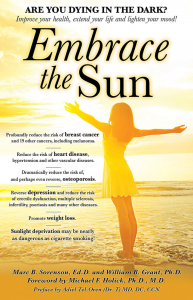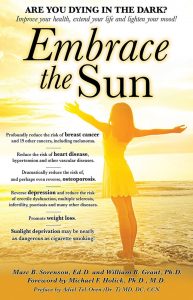Mental illness: Vitamin D deficiency, and thereby sunlight deficiency, plays a major role. By Marc Sorenson, EdD.
Mental illness is a pandemic in the United States. Nearly one in five U.S. adults live with a mental illness (46.6 million in 2017). Mental illness has multiple causes and manifestations. It is especially relevant to understand that sunlight deprivation, leading to vitamin D deficiency, plays a major role in this disorder. It is also important to realize that sun exposure, for typical people, produces about 90% of serum (blood) vitamin D. In addition, this production occurs when midday sunlight touches the skin. However, vitamin D is only one of several photoproducts produced by sun exposure to skin or other body parts. In addition, sun exposure produces serotonin, endorphin, dopamine, and brain-derived neurotropic factor (BDNF). Furthermore, all of these vital chemicals has a profound influence on mental Illness.
An important study on vitamin D
The disease is ubiquitous, as is sun deprivation. Thus, thus an investigation on vitamin D and mental illness reminded me of the affects of sunlight. This laboratory-based study found a high prevalence of vitamin D deficiency among 290 patients with mental illness. Consequently, Only 18% of these patients showed adequate levels of vitamin D. To me, this also means that only 18% were obtaining sufficient sun exposure for good mental health and well-being. The researchers concluded that sensible sun exposure could be a boon to mental health.
Let us now discuss a few of the disorders classified as types of mental illness. Then we will also mention the research that indicates an impressive salutary influence of sun exposure.
ADHD, a mental illness of children
ADHD ( attention deficit hyperactivity disorder) is the most prevalent of all mental disorders in children. Hence, it causes significant problems with executive functions, leading to hyperactivity or impulsiveness not appropriate for the person’s age.
Researchers have found that sun exposure correlates to a decreased risk of ADHD. They assessed the relationship between the prevalence of ADHD and the intensity of the sun in various nations and in US states. And after adjusting for birth weights, infant mortality and other relevant factors, the findings were not altered. It was obvious that sun deprivation by itself was associated with a higher risk of ADHD.
Autism, another disease of youth
Is autism a sun-deficiency disorder? Autism rates are increasing exponentially and associate to vitamin D deficiency, which, of course, associates to sun deficiency. The Autism Society of America defines autism as “a complex developmental disability typically appearing during the first three years of life and is the result of a neurological disorder affecting the normal functioning of the brain, impacting development in the areas of social interaction and communication skills. Both children and adults with autism typically show difficulties in verbal and non-verbal communication, social interactions, and leisure or play activities.”
If vitamin D deficiency and/or sun deprivation relates to autism, symptoms should improve in summer. Thus, a case study reported by Dr. Cannell revealed improvements in autism-related sleep and behavioral problems during summer. Autistic traits such as crying, excitability, hyperactivity and pounding objects profoundly diminished during summer.
Bipolar Disorder
Bipolar disorder (BPD), also known as manic-depressive illness, is a brain disorder causing unusual shifts in mood, energy, activity levels, and the ability to perform day-to-day tasks. Symptoms are severe and can result in damaged relationships, poor job or school performance and even suicide.https://www.nimh.nih.gov/health/topics/bipolar-disorder/index.shtm
Sun exposure resets the body’s circadian rhythms, which are variations in physiology and behavior persistent with a cycle length close to 24 hours. This system is contained in the hypothalamus and stimulated by nerve cells in the retina of the eye in response to light. Research indicates that environmental conditions early in life may imprint the circadian system and influence mental function later in life: Increased number of hours of daylight at the location of birth during the first three months of life are associated with a significantly older age of onset of bipolar disorder. For a longer discussion on bipolar disorder, read the book, Embrace the Sun.
Cognitive disabilities (intellectual disorders)
Another research study, based on a 15-year residential history of varying degrees of sun exposure, produced an interesting result. It showed that cognitive impairment in persons who were below the median exposure to sunlight was 88% greater than in those who were above the median. These same investigators had previously shown that lower levels of sun exposure resulted in a 2.6-times higher incidence of cognitive impairment. Therefore, if you want to think clearly and keep your marbles, regularly soak up some non-burning sunlight.
Depression
Few people realize how prevalent depression is in our society, a mental illness representing a huge drain on the economy. Moreover, according to Steven Genuis, in an editorial in Canadian Family Physician, “The World Health Organization estimates depression costs the American economy about $44 billion annually, equal to the total cost of all cardiovascular diseases.” He also stated that in one decade, there was a 300% increase in the sales of antidepressants, making these medications the top-selling pharmaceuticals in the world. (Genuis, S. Keeping your sunny side up (editorial). Canadian Family Physician 2006:52:42-43.)
So what does the sun do to relieve “the blues?”
The answer probably lies in a chemical responsible for transmitting impulses between nerve cells. This “neurotransmitter,” serotonin, is a natural “upper,” and works in synchronization with the natural “downer,” melatonin. When we awake to sunshine, light enters the eye and stimulates serotonin production. We then quickly become awake and invigorated, and melatonin diminishes. Nevertheless, at day’s end, the bright light disappears (or at least it should), melatonin levels rise, and serotonin levels diminish. We begin to feel sleepy and ideally retire for a good night’s rest. It is a perfect system for our needs—unless we stay up beyond biologically natural hours, by using artificial lighting. Many experts believe that lack of serotonin is a cause of depression.
The most important study on serotonin
Though I mentioned this study in my previous blog on sunlight and depression, it bears repeating here. Dr. Gavin Lambert performed one of the most important and unique studies on serotonin. He and his colleagues measured serotonin levels in response to varying degrees of sunlight. First of all, they drew blood samples from the internal jugular veins of 101 men. In addition, they compared the serotonin concentrations of the blood to weather conditions and seasons. As a result, men measured on a bright day produced eight times more serotonin, than those measured on a dismal day. Of course, the mood improved due to sunlight, with no involvement whatsoever of vitamin D. Thus, regular, non-burning sun exposure is the answer to depression. In addition, remember that sun exposure also leads to the production of other mood enhancers such as nitric oxide, endorphin and dopamine.
Certainly, sunlight deprivation is not the only cause of mental illness, but it is one of the most important.
There are more mental illnesses to discuss, and I will expatiate on those in a future article. In the meantime, protect your mental health by being sure to obtain your share of non-burning sunlight. For more information, visit sunlightinstitute.org, and read the book, Embrace the Sun.
Mood is essential to a happy life and wellbeing. By Marc Sorenson, EdD
Mood (a good mood) is critical to optimal living, and those who work in natural light experience improvement. In addition, a good mood leads to better performance, behavior and psychological health.  Furthermore, very few things improve wellbeing like arising early in the morning and walking outside on a sunny day: Our attitude improves too, and our serotonin and endorphin levels increase. Consequently, there is an almost immediate feeling of exhilaration. So, we become happier and less confrontational, and our minds seem to click on all cylinders. This mood change is all due to the morning sun exposure. Does midday sun exposure also help?
Furthermore, very few things improve wellbeing like arising early in the morning and walking outside on a sunny day: Our attitude improves too, and our serotonin and endorphin levels increase. Consequently, there is an almost immediate feeling of exhilaration. So, we become happier and less confrontational, and our minds seem to click on all cylinders. This mood change is all due to the morning sun exposure. Does midday sun exposure also help?
Mood and midday sunlight
Later on, around midday, we produce large quantities of vitamin D, and our nitric oxide levels increase. That is, of course, if we are fortunate enough to safely sunbathe (with a lot of skin exposed). As a result, we experience a delicious feeling of relaxation and a lowering of blood pressure as the cares of the day melt away. Therefore, mood is again enhanced.
Mood and sun robbery
Regrettably, due to various factors, most of us live in a society robbed of the sun. We are confined to artificially lighted buildings and poor little cubicles and our mood is crushed. These little cubicles, of course, seem like prison cells that won’t allow our happiness to manifest itself.
Consequently, concerned scientists are recognizing that modern humans suffer from artificial, insufficient light in their lives. So these scientists are advocating a return to natural light. One of their studies on the subject of light and mood is most noteworthy. They, due to their concern about light availability measured the impact of windows and daylight on mood. They studied the physiological, psychological and behavioral health of working nurses.[1] First of all, they used biological measurements, behavioral mapping and data analysis in a nursing unit of two wards. While both wards exhibited similar conditions, one ward had more windows and more natural lighting than the other.
Impressive mood results:
As a result, in the ward with more windows and natural light, the nurses had better health. They had lower blood pressure and higher body temperature, less sleepiness and a better mood. Communication and laughter also increased. Heart rates were shown to be lower with greater exposure to light, and caffeine intake was reduced as well. In conclusion, mood was improved, as was performance. Rana Zedeh, the lead researcher of that study, made the following statement:[2] “Research has shown a range of different outcomes are impacted by sun, including regulation of the circadian rhythm, shorter length of stay for patients, reduced perception of pain for patients, and reduced anxiety and agitation among elderly patients with dementia. Improved outcomes for patients also help staff manage their patients better.”
Change the environment, change the mood.
Finally, one can only imagine the potential benefits that could be realized if unencumbered sun rays are allowed. Vitamin D production would increase, and it is likely that patients as well as nurses would improve their health.
Hence, Dr. Zadeh also made this declaration: “Intelligently designed clinical workspaces could lead to higher safety and quality levels… By default, when we think of a healthcare workspace, we may think of a large, deep building with no windows for staff, little access to greenery or outdoors, an institutional feel, complex way-finding, and monotonous color and lighting. Knowing how the human brain receives stimuli from the environment and constantly changes neural hormonal responses controlling cognitive performance and alertness, we might be able to improve outcomes by creating more vigilant and restorative elements in environments.”[3] The translation is, “elevate your mood by getting out of the little dark boxes and back into the sun.”
 How does the sun work to improve mood?
How does the sun work to improve mood?
First of all, what does the sun do to relieve “the blues?” The answer lies in a chemical responsible for transmitting impulses between nerve cells. This “neurotransmitter,” serotonin, is a natural “upper,” working in synchronization with the natural “downer,” melatonin. So, when we awake to sunshine, light enters the eye and stimulates serotonin production. Because of this reaction, sunlight can dramatically increase serotonin levels in the brain and immediately improve mood.
Dr. Gavin Lambert and his colleagues in Australia measured serotonin levels in response to varying degrees of bright light. [4] To do so, they drew blood samples from the internal jugular veins of 101 men and compared the serotonin concentrations of the blood to weather conditions and seasons. The remarkable results: Men who were measured on a bright day produced eight times more serotonin. That is, compared to those who were measured on a dismal day. Of course, the mood was improved due to sunlight.
Get your regular, non-burning sun exposure and enhance your good mood!
[1] Zadeh RS, Shepley MM, Williams G, Chung SS. The impact of windows and daylight on acute-care nurses’ physiological, psychological, and behavioral health. HERD 2014 Summer;7(4):35-61.
[2] Katy Mena-Berkley. Mood: the Science of Letting the Sunshine In. MD News
[3] Katy Mena-Berkley. Mood: the Science of Letting the Sunshine In. MD News
[4] Lambert GW, Reid C, Kaye DM, Jennings GL, Esler MD. Effect of sun and season on serotonin turnover in the brain. Lancet. 2002 Dec 7;360(9348):1840-2.
Breast cancer breakthrough.  By Marc Sorenson, EdD. Sunlight Institute
By Marc Sorenson, EdD. Sunlight Institute
Stunning Breast Cancer research shows that the highest vitamin D levels associate with an 80% reduction in risk.[1]
Is the breast cancer pandemic due to vitamin D deficiency?
First of all, as pointed out by the authors, numerous studies have shown an association between higher vitamin D level and breast cancer. But, other studies had not taken into consideration serum levels of vitamin D above 40 ng/ml. Why? Because that level had been considered the highest level needed for good health. Nevertheless, this study showed differences in breast cancer risk when comparing all serum vitamin D levels, and that made all the difference in the results. The research included 5,038 women .
.
A dose-response association between vitamin D levels and breast cancer
The most noteworthy finding can be summed up in the study conclusions: “Higher 25(OH)D concentrations were associated with a dose-response decrease in breast cancer risk with concentrations ≥60 ng/ml being most protective.” In other words, the higher the vitamin D levels, the greater was the protection.
This fact is especially relevant: serum vitamin D levels in 90% of the population are effected by sun exposure. Hence, sun exposure may be the operative factor in the comparisons. Sun exposure causes the body to produce nitric oxide, serotonin, endorphin and brain-derived neurotropic factor (BDNF). Most noteworthy is that all of these photoproducts are vital to human health.
Is something besides vitamin D at work in preventing breast cancer?
Therefore, it could be that these additional photoproducts added power to the vitamin D produced by the sun. Could the “holistic” sun be more important than vitamin D alone? Of course it is! Another study, little known, may hold the answer. An investigation from Iran, on the association between breast-cancer risk and vitamin D, showed that low vitamin D predicted only a slightly increased risk of the cancer. However, among women who totally covered themselves and thereby had no sun exposure, there was a 10-fold increase in the risk of the disease.[2] In other words, there was a 1,000% increase in breast cancer risk due to sun deficiency.
Summary:
Finally, consider this: With the holistic sun, we get the entire package, not just vitamin D. Embrace the Sun, and don’t burn.
For more on the study, see the press release put out by the Vitamin D Society: http://www.vitamindsociety.org/press_release.php?id=58
[1] Sharon L. McDonnell , Carole A. Baggerly, Christine B. French, Leo L. Baggerly, Cedric F. Garland, Edward D. Gorham, Bruce W. Hollis, Donald L. Trump, Joan M. Lappe. Breast cancer risk markedly lower with serum 25-hydroxyvitamin D concentrations ≥60 vs <20 ng/ml (150 vs 50 nmol/L): Pooled analysis of two randomized trials and a prospective cohort. PLoS One. 2018 Jun 15;13(6)
[2] Bidgoli SA, Azarshab H. Role of vitamin D deficiency and lack of sun exposure in the incidence of premenopausal breast cancer: a case control study in Sabzevar, Iran. Asian Pac J Cancer Prev. 2014;15(8):3391-6.
Marc Sorenson, EdD, for breast cancer prevention. 
While many doctors know that ultraviolet radiation (UVR) from sunlight reduces risk of breast cancer, they have missed something. UVR stimulates production of vitamin D in human skin. Therefore, many health professionals assume that vitamin D is responsible for the reduced cancer risk. This may lead them to advocate the use of vitamin D supplementation and totally miss the bigger picture. In addition to vitamin D, UVR from sunlight or sunlamps produces many supplementary healthful photoproducts. Among others, nitric oxide, serotonin, endorphin and BDNF are produced by sunlight, and these photoproducts are vital to health. And, it is likely that these healthful photoproducts lead to an inhibition of breast cancer.
New research shows that sun exposure per se is capable of reducing the risk of breast cancer.
Consequently, it should not surprise us that for breast cancer, sunlight’s effects go beyond vitamin D.[1] Researchers at Children’s Hospital Oakland Research Institute, used a murine model (mice) that easily develops breast cancer, and treated them with UVR. Much as we might expect, they found that UVR treatments produced significant anti-cancer effects. Furthermore, they found that neither dietary vitamin D nor topical vitamin D influenced cancer risk. Because of their findings, they stated the following: “UVR’s inhibitory effects occur irrespective of whether or not the treatment increases circulating D3 in the mice.” Also, they made one more important comment regarding their research on breast cancer and UVR. “Therefore, supplemental D3 may not mimic all possible beneficial effects of UVR, and uncovering non-D3-mediated mechanisms of UVR tumor inhibition may lead to novel strategies for cancer prevention.”
An important point about vitamin D, sunlight and breast cancer.
Finally, there is no doubt that vitamin D has anticancer benefits. This research however, is especially relevant in that it corroborates what I have said in my soon-to-be-released book, Embrace the Sun. First of all, we must not put all of the benefits of sunlight in the vitamin D box. Secondly, sun exposure performs myriad miracles beyond vitamin D. One of those miracles may be breast cancer prevention and inhibition. Thirdly, if we erroneously believe that we can obtain all of the sun’s benefits from popping a vitamin D pill, we may miss the holistic effects of the sun, which provide a cornucopia of salubrious results.
So, safely (without burning) embrace the sun and ease your mind about breast cancer.
[1] Anastasia M. Makarova, Flora Frascari, Parastoo Davari, Farzam Gorouhi, Philip Dutt, Lynn Wang, Akash Dhawan, Grace Wang, Jeffrey E. Green, Ervin H. Epstein, Jr. Ultraviolet radiation inhibits mammary carcinogenesis in an ER negative murine model by a mechanism independent of vitamin D3. Downloaded from cancerpreventionresearch.aacrjournals.org on April 12, 2018.
 Although liver cancer is generally thought to be related to drinking, other factor such as obesity, HIV infection, smoking, diabetes, socioeconomic factors, drugs and others come into play. A recent study compared sun exposure to liver cancer and adjusted for the aforementioned factors. Sun exposure was shown to be a major factor in reducing the risk of the most prevalent and deadly liver cancer, called hepatocellular carcinoma.[1]
Although liver cancer is generally thought to be related to drinking, other factor such as obesity, HIV infection, smoking, diabetes, socioeconomic factors, drugs and others come into play. A recent study compared sun exposure to liver cancer and adjusted for the aforementioned factors. Sun exposure was shown to be a major factor in reducing the risk of the most prevalent and deadly liver cancer, called hepatocellular carcinoma.[1]
Major finding for liver cancer:
The subjects were divided into five groups, or quintiles, based on their sun exposure. In addition such factors as as outdoor activity, geographical residence, urban or rural settings, etc. were adjusted for.
Most noteworthy, was the fact that for each quintile of increasing sun exposure, there was a 17% decrease in the liver cancer risk.
A disappointment:
The only disappointing part to the study was this: The researchers assumed that the positive influence of sun exposure on liver cancer was due to vitamin D production. And, they may have been correct. Yet the sun causes the body to produce many other photoproducts. Due to the sun’s myriad effects, serotonin, endorphin, BDNF, nitric oxide, and dopamine are all increased. Therefore, it is impossible to know if vitamin D alone was the reason for the reduced risk of liver cancer. However, vitamin D undoubtedly played a large part in the positive results. And, there is a problem with giving vitamin D the credit without knowing for sure. People may believe, due to this research, that they need only to take a vitamin D supplement to receive all benefits of sunlight. Therefore, they can make very bad assumptions.
This is the first study on sun exposure and liver cancer.
Probably, this is the first research to show a link between liver cancer and inadequate sun exposure. However, there are indications that sun exposure is associated with a reduced risk of another liver ailment, called fatty liver disease.[2]
In conclusion, if you are a liver lover, you can love your liver by protecting it from liver cancer. Hence, you should obtain your share of unscreened, direct, non-burning sun exposure. Happy sunning!
[1] Trang VoPham, Kimberly A. Bertrand, Jian-Min Yuan, Rulla M. Tamimi, Jaime E. Hart,
and Francine Laden. Ambient ultraviolet radiation exposure and hepatocellular carcinoma incidence in the United States. Environmental Health (2017) 16:89.
[2] Gorman S, Black LJ, Feelisch M, Hart PH, Weller R. Can skin exposure to sun prevent liver inflammation? Nutrients 2015 May 5;7(5):3219-39.
 Bipolar disorder, or bipolar depression, may lead to early death. It is a mental condition characterized by alternating mania and depression, usually interspersed with normal mood. And, it also may include psychosis. Because of the alternating moods, bipolar disorder was previously called manic-depressive illness. The word “manic” means excessive activity, euphoric mood, and impaired judgement.
Bipolar disorder, or bipolar depression, may lead to early death. It is a mental condition characterized by alternating mania and depression, usually interspersed with normal mood. And, it also may include psychosis. Because of the alternating moods, bipolar disorder was previously called manic-depressive illness. The word “manic” means excessive activity, euphoric mood, and impaired judgement.
Bipolar disorder affects about 5.7 million adult Americans, and one in 5 people who have the condition commits suicide. Furthermore, the U.S. has the highest bipolar rate in the world.[1] Bipolar disorder is also the sixth leading cause of disability in the world. In addition, it results in a 9.2-year reduction in the expected life span.[2]
New (and very exciting) research demonstrates that bright-light therapy has a profound and positive influence on this disease.[3] The researchers conducted a 6-week program to investigate the value of bright light therapy at midday for bipolar depression. The study participants were chosen from depressed adults who were receiving stable dosages of anti-manic medication. The subjects were randomly assigned to treatment in one of two groups: the bright-white light (7,000 lux) group or dim-red light (50 lux) group.
At the end of the six-week period, 68% of the bright-light group went into remission of their bipolar problems, compared with 15% of the dim-light group. This is a most noteworthy result.
The study provides transcendently important information for those who suffer from this debilitating mental disorder. Therefore, the researchers summarized their findings thusly: “The data from this study provide robust evidence that supports the efficacy of midday bright light therapy for bipolar depression.”
The mechanism by which bright-light therapy performs its anti-depressive miracles is probably through production of serotonin in the brain. When we are surrounded by bright light, the light enters the eye and stimulates the brain to produce serotonin. Serotonin is the master mood enhancer, and anti-depressant drugs work by manipulating serotonin. Hence, these drugs are called selective serotonin uptake inhibitors (SSRI). However, SSRI often have serious, sometimes deadly, side effects. We should therefore obtain our serotonin naturally, through regular sun exposure. Why? Because serotonin can be increased by as much as 800% by spending a day in the sunlight.[4] What a marvelously simple therapy bright light is. And what is the easiest way to obtain it? Go outside during the day, for goodness sake!
It is not necessary to go outside at midday. Any time of day, when the sun is shining brightly, should work very well. However, we should never look directly at the sun. That may cause eye damage. Sufficient light enters just by being outside.
In conclusion: Safely embrace the sunlight whenever possible, and remove the risk of bipolar disorder.
[1] Amanda Gardner. U.S. has highest bipolar rate in 11-nation study. Heath.com. March 7, 2011. http://www.cnn.com/2011/HEALTH/03/07/US.highest.bipolar.rates/
[2] Bipolar Disorder Statistics. BDS Alliance. http://www.dbsalliance.org/site/PageServer?pagename=education_statistics_bipolar_disorder.
[3] Sit DK, McGowan J, Wiltrout C, Diler RS, Dills JJ, Luther J, Yang A, Ciolino JD, Seltman H, Wisniewski SR, Terman M, Wisner KL. Adjunctive Bright Light Therapy for Bipolar Depression: A Randomized Double-Blind Placebo-Controlled Trial. Am J Psychiatry. 2017 Oct 3: [Epub ahead of print].
[4] Lambert GW, Reid C, Kaye DM, Jennings GL, Esler MD. Effect of sun and season on serotonin turnover in the brain. Lancet. 2002 Dec 7;360(9348):1840-2.
A recent sunshine article in the UK online newspaper, The Mail, led with the headline, “Sunshine breaks could mean better mental health.” It then went on to describe how many shift workers, as well as other residents of the UK, are deficient in vitamin D.[1] Quoting from research published in the Journal BMC Public Health,[2] the article stated that about 91% of residents are at least insufficient in vitamin D.
Vitamin D deficiency of that extent is a health crisis, of that there is no doubt. It is also a surety that the way to combat vitamin D deficiency is by taking “sunshine breaks.” However, it is misleading to assume it is vitamin D deficiency that is responsible for the entire problem with mental health and other diseases as they relate to sun exposure. Consider the fact that lack of sunshine deficiency also causes problems beyond vitamin D deficiency. For example, the natural 24-hour cycles, called circadian rhythms, are desynchronized by lack of sunshine in the morning. This causes us to feel out of synch and to be more susceptible to many diseases including cancer.
Remember that sun exposure also leads to the production of serotonin,[3] endorphin,[4] dopamine,[5] and BDNF,[6] all of which have a positive effect on mood and mental health.
Sunshine is vital to mental and physical health, and that health is not due to vitamin D alone. Take a holistic view of the importance of sunshine.
[1] http://www.nwemail.co.uk/news/Sunshine-breaks-could-mean-better-mental-health-88b00574-032c-4467-846c-1eff0514d4e8-ds
[2] Sowah D, Fan X, Dennett L, Hagtvedt R, Straube S. Vitamin D levels and deficiency with different occupations: a systematic review. BMC Public Health. 2017 Jun 22;17(1):519.
[3] Lambert GW, Reid C, Kaye DM, Jennings GL, Esler MD. Effect of sun and season on serotonin turnover in the brain. Lancet. 2002 Dec 7;360(9348):1840-2.
[4] Asta Juzeniene and Johan Moan. Beneficial effects of UV radiation other than via vitamin D production: Dermato-End Holick, M. The UV Advantage 2. Ibooks 2003, New York. Ocrinology 2012;4(2):109–117.
[5] Holick, M. The UV Advantage 2. Ibooks 2003, New York.
[6] Molendijk ML, Haffmans JP, Bus BA, Spinhoven P, Penninx BW, Prickaerts J, Oude Voshaar RC, Elzinga BM. Serum BDNF concentrations show strong seasonal variation and correlations with the amount of ambient sun. PLoS One. 2012;7(11):e48046.
By Marc Sorenson, EdD for sun exposure and health…
The Vitamin D Society of Canada has just released one of the best articles on the relationship of sun exposure and its potential for vitamin D production. Sun exposure is the natural way to obtain your essential vitamin D, and of course provides other essential photoproducts such as nitric oxide, serotonin, endorphin and BDNF.
Here is the press release from the Vitamin D Society, in full:
NEWS RELEASE
For Immediate Distribution
TORONTO, Ont (April 4, 2017) – The daylight hours are getting longer, the sun is getting stronger and summer is just around the corner. Make this the year that you optimize your vitamin D levels through effective sun exposure. Enjoy the health benefits and disease prevention from optimal vitamin D levels and learn to control your risks from sun exposure.
Vitamin D is made naturally in your body when UVB rays from the sun convert cholesterol in your skin to pre-vitamin D3. We make about 90% of our vitamin D from UVB sun exposure. UVB rays are short and only reach the earth when the sun is directly above us. We can’t make vitamin D in the winter in Canada because the sun is at too low of an angle and the UVB rays are absorbed in the atmosphere.
You make vitamin D in Canada between the months of May and October. The best time for exposure is around midday, between 10am and 2pm, when the UV index is above 3 and your shadow is shorter than your height. The further you get from noon, the lower the amount of vitamin D you’ll make. The sun’s visible light may penetrate through glass, but UVB light will not; therefore you will not make vitamin D.
Full body sun exposure at non-burning levels can create between
10,000-25,000 IU of vitamin D in your skin. You can never get too much vitamin D from the sun as your skin self regulates, whereas ingesting vitamin D does not have the same control. In addition, vitamin D that you make from the sun lasts twice as long in your body as vitamin D taken through supplements or food.
Statistics Canada reports that Canadian vitamin D levels have dropped by 10% over the past six years. The root cause of this decrease is lower sun exposure. People are just not getting outside around midday in the summer and making vitamin D, and when they are outside they are using sunscreen, which if applied correctly prevents 95%+ of vitamin D production.
In Canada, 12 million Canadians (35%) have vitamin D blood levels below the recommendations from Health Canada. This puts these people at a higher risk for several diseases, including cardiovascular disease, cancer, osteoporosis, diabetes, multiple sclerosis, Alzheimer’s disease and many more. In fact, a study completed in 2016 reported that if Canadians increased their vitamin D levels to the recommended level of 100 nmol/L, we would save $12.5B in healthcare costs and 23,000 premature deaths annually.
A recent study reported that women who avoided the sun have twice the risk of all cause death. The authors said that “avoidance of sun exposure is a risk factor for death of a similar magnitude as smoking.”
Skin cancer is a concern and risk of sun exposure must be managed and balanced with the benefits from vitamin D and other photoproducts. Research has shown that people with higher sun exposure such as outdoor workers, who have 3-10 times the sun exposure as indoor workers, have a lower incidence of melanoma. The National Cancer Institute reports that
melanoma risk is increased as a result of intermittent acute sun
exposure leading to sunburn. People who are a skin type 1, with white or very pale skin colour, red or blonde hair colour and who always burn and never tan, should severely limit their sun exposure.
The Vitamin D Society offers the following tips:
– Know your own skin and skin type. Don’t burn. Never overexpose yourself.
– Acclimatize or condition your skin for sun exposure by gradually
building or lengthening exposure times as your skin begins to tan to reduce your risk of burning
– Prevent burning and overexposure when required through the use of hats, clothing, shade and sunscreens.
– For vitamin D, get sun exposure at midday, between 10 am and 2 pm, when the UV index is above 3 and your shadow is shorter than your height.
– Expose more skin for a shorter period of time to generate more vitamin D while reducing your risk of overexposure.
It’s important to manage the risk and enjoy the rewards of moderate sun exposure for good health. Cancer Research UK, through the Consensus Vitamin D Position Statement, offers the following recommendation:
“Enjoying the sun safely, while taking care not to burn, can help provide the benefits of vitamin D without unduly raising the risk of skin cancer.”
“This advice may go against what current health organizations
recommend,” says Perry Holman, Executive Director of the Vitamin D Society. “They typically recommend you stay out of the sun at midday and use sunscreen when outdoors. But this would reduce your potential vitamin D production and does not consider the benefits as well as the risks of sun exposure on overall health. You need to have balance.”
About the Vitamin D Society:
The Vitamin D Society is a Canadian non-profit group organized to increase awareness of the many health conditions strongly linked to vitamin D deficiency; encourage people to be proactive in protecting their health and have their vitamin D levels tested annually; and help fund valuable vitamin D research. The Vitamin D Society recommends people achieve and maintain optimal 25(OH)D blood levels between 100 –
150 nmol/L (Can) or 40-60 ng/ml (USA).
To learn more about vitamin D, please visit www.vitamindsociety.org
For more information, please contact:
Melissa Andrade, Enterprise Canada 905-346-1230
mandrade@enterprisecanada.com.
THIS PRESS RELEASE CONTAINS MUCH OF WHAT YOU NEED TO KNOW ABOUT VITAMIN D, SUN EXPOSURE AND HEALTH. Please read it carefully, as it could save your life.
Marc Sorenson.
By Marc Sorenson, EdD: friend of the Sun.
Babies who cry at night rather than sleep can wreak havoc on the health, wellbeing and work performance of their parents, so any natural method of helping the baby to sleep well would be welcomed in most families. One of the best natural methods is to expose the baby to outdoor light, and research showed that infants who slept well were exposed to significantly more early-afternoon light than their counterparts who did not sleep well.[1] We have discussed previously in this blog that circadian rhythms are controlled to a great extent by sun or the lack thereof, and these researchers stated, “These data suggest that light in the normal domestic setting influences the development of the circadian system.” Proper circadian rhythms are also vitally important for adults, and when disrupted predict an increase in illness and death from many maladies, particularly from our number-one killer, cardiovascular disease.[2]
Melatonin, which should exhibit high levels at night, is a sleep inducer, and its production is enhanced when the lights go out at night. But, for that to happen, there must be sufficient bright light earlier in the day.
For babies or adults, here is how the system should work: When we awake to sunshine, light enters the eye and stimulates serotonin production; we then quickly become awake and invigorated, and melatonin is suppressed. At day’s end, however, the bright light disappears (or at least that is how nature intended it), melatonin levels rise, and serotonin levels diminish. We begin to feel sleepy and ideally go to bed for a good night’s rest. It is a perfect system for our needs—that is until we stay up far beyond biologically natural hours by using artificial lighting.
Is there and answer to a disrupted circadian rhythm and poor sleep quality? Yes! A paper entitled Circadian clocks optimally adapt to sun for reliable synchronization has the answer.[3] In it, the authors explain that circadian rhythms are best synchronized by sun. It therefore occurs that to escape the ravages of electric lighting, it would be a good idea to reset our biological clocks daily by being out in the morning sun and at other times, when possible, and to avoid long hours of light exposure at night. This could be one of the best therapies possible when we feel “out of synch.” And, catching some sun throughout the day would also keep serotonin levels higher and keep our moodiness in check. All of us know that we feel better when we are in the sun. This, coupled with enhancement of health, demonstrates that our friend, the sun, is an essential companion for optimal living.
So take care of your babies as nature intends, and also take care of yourself with non-burning daily sun exposure.
[1] Harrison Y. The relationship between daytime exposure to light and night-time sleep in 6-12-week-old infants. J Sleep Res. 2004 Dec;13(4):345-52.
[2] Jason Brainard, Merit Gobel, Benjamin Scott, Michael Koeppen and Tobias Eckle. Health implications of disrupted circadian rhythms and the potential for daylight as therapy. Anesthesiology. 2015 May ; 122(5): 1170–1175.
[3] Hasegawa Y, Arita M. Circadian clocks optimally adapt to sun for reliable synchronization. J R Soc Interface. 2013 Dec 18;11(92):20131018.
Benefits of sun exposure, by Marc Sorenson, EdD…
Interesting research regarding the critical necessity of sun exposure continues to mount.
There is no doubt that lack of sun exposure leads to disease, and a major factor in that scenario is a disrupted circadian rhythm. Researchers have stated that “Exposure to sunlight during the day, and darkness at night, optimally entrains biological rhythms to promote homeostasis and human health. Unfortunately, a major consequence of the modern lifestyle is increased exposure to sun-free environments during the day and artificial lighting at night.”[1] Night-shift work is one of the worst contributors to the disruption of our natural biological rhythms, also known as circadian rhythms, and it certainly defines the sun-free environment discussed. There is a strong association of night-shift work to many diseases, but one of the most prevalent of these is breast cancer.
So what is natural and good for the health? Researchers have shown that a disrupted circadian rhythm can be reprogrammed, or “entrained” by exposure to a natural summer, meaning a cycle of 14 hours, 40 minutes of summer light, to 9 hours, 20 minutes of darkness.[2] The authors state that this “light-dark cycle programs the human circadian clock to solar time, such that the internal biological night begins near sunset and ends near sunrise.”
Such a cycle would certainly seems natural for humans who were raised on ranches or farms where the day’s activities begins early in the morning sunlight and usually end near sunset. I know, because that pattern described my youth. For primitive peoples, that cycle was probably a necessity to gather the food necessary for survival. It is now ingrained in to our DNA, and disruption leads to disease.
So how are circadian rhythms reset to help our health? According to the aforementioned research (footnote 2), it can be accomplished by either a week of natural light exposure, or a weekend spent camping in nature. I am a camper, and I know that when the sun goes down, I am ready to sleep, and when the sun rises the next morning, I’m ready to start my day’s adventures.
The message here is that daytime should be spent outside in natural light. This will probably reduce the risk of many diseases, including breast cancer. It is also imperative that our skin receives its sun exposure to produce vitamin D and other healthful photoproducts. In addition being outside in the sun will increase our production of serotonin and enhance our moods.
Safely embrace the sun and save your life! Be sure not to burn.
[1] Ball L, Palesh, O, Kriegsfeld L. The Pathophysiologic Role of Disrupted Circadian and Neuroendocrine Rhythms in Breast Carcinogenesis. Endocr Rev. 2016 Oct;37(5):450-466.
[2] Stothard ER, McHill AW, Depner CM, Birks BR, Moehlman TM, Ritchie HK, Guzzetti JR, et al.





